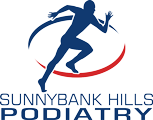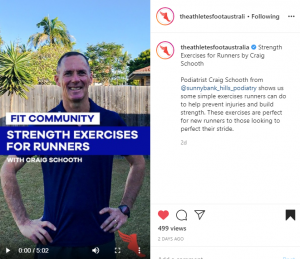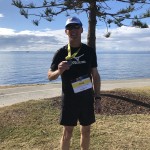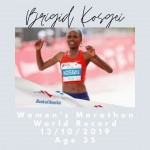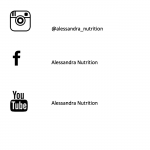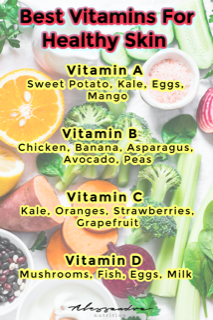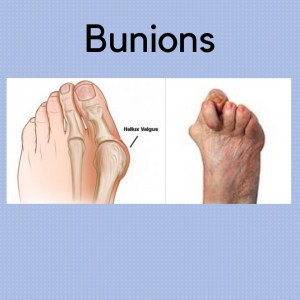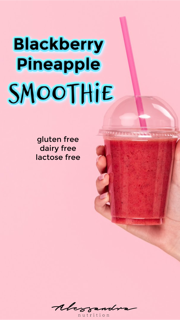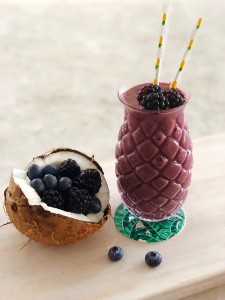Its More Than Just Feet – June 2020
June 2020 – Update
In this issue, I will fill you in on what I have been up to during recent times. I am very excited to introduce Alessandra Trovato, who is a Nutritionist with a passion for helping people reach their Nutrition Goals and living a healthier life. Alessandra will be sharing some sensational recipes and advice on a regular basis. We will also learn a little more about the Masters’ Athlete and Bunions- the What, Why & How.
What has Craig been doing?
With the recent restrictions, we have all had to think a little differently about how we do things. Every part of our daily lives seems to have been impacted in one way or another. It has been fantastic to see that our community has been adhering to the relevant advice and that we are all benefiting as the restrictions are slowly being lifted.
During late April, I had been fortunate to have been approached by The Athletes Foot, Australia, to provide some content for their social media pages, to provide some advice on home-based exercises during the lock-down period. Check it my video here
Two of my passions, running and surf lifesaving were also forced to do things a little differently. For surf lifesaving, it meant that the Red & Yellow Flags were not raised, however, our beaches were still patrolled in a “Surveillance” mode. Lifesavers were still on our beaches, with reduced numbers but still keeping the public safe.
As for running, we were still able to get out and exercise within guidelines, however, like most sports, competition has been suspended. I had plans of competing at the Brisbane Marathon Festival and had entered into the half marathon. The organisers of the event quickly made the decision to turn their event into “Virtual Event”, which meant participants could continue training towards their goals and the event would still go ahead, but just in a different format. Essentially the participants completed their event at a location of their choice at their chosen time over the weekend of 6-7th of June and then were asked to submit evidence of their run (data from their running watches). The organisers complied and published their official results. As for me, I completed my half marathon at the Wynnum foreshore, in perfect running conditions and was fortunate to place 3rd in my age category.
The Masters’ Athlete
When we hear the term “Masters Athlete”, connotations of a very old athlete at the end of their career, are often derived. The reality is that a Masters Athlete is an athlete over the age of 35! If we look at endurance sports, in particular, some of our “Masters Athletes” are competing at the highest of elite levels in events such Marathons and Ironman Triathlons.
So what is it that makes the Masters’ Athlete different to their younger counterparts? In a recent Podcast, Professor Peter Reaburn, (Head of Program, Bond University’s Institute of Sport & Health) discussed the many physiological changes and adaptations the Masters’ Athlete goes through as well as some keys to success for training and recovery of the Masters’ Athlete.
Professor Reaburn indicates two main contributors to age-related changes in Masters Athletes, a significant decrease in muscle mass and a decrease in maximum heart rate.
With respect the reduced muscle mass, it is the fast-twitch muscle fibres which decrease in size and then result in a reduction in strength and speed for the athlete. In terms of reduced heart rate, as we age our maximum heart rate reduces by 3.2% per decade. This decrease in heart rate results in a decrease in cardiac output/ stroke volume which in turn reduces the amount of oxygen and nutrients delivered to the muscles and affects performance.
So how do we offset these changes?
For reduced muscle mass, strength training is the key. Strength training is important to reduce injury risk and a decrease in age-related performance losses. It has been suggested that the Masters’ Athlete should include strength/ resistance training in their weekly program. If time constraints are an issue consider replacing 1-2 regular sessions with strength training.
For reduced maximum heart rate, training intensity is the main area of focus. Research as shown that Masters Athletes who regularly train at high intensity over many years increase risk cardiac issues, particularly Arial Fibrillation (irregular & fast heartbeat). When training it is important not to spend too much time with your heart rate in the threshold zone (above 80% of maximum heart rate). It is recommended that your weekly training should be 20% High-Intensity Interval Training and 80% Long Slow Distance.
Additional Changes In the Aging Athlete
- A general decrease in training intensity, tend to lean more to endurance sports
- Tend to run more economically (pace themselves better) than their younger counterparts
- Recovery – physiologically, recovery is similar between young & Masters Athletes, however, Masters Athletes typically perceive their recovery takes longer. (Listen to your body, not the mental perception of recovery)
- Thermal tolerance – related to aerobic capacity, thirst mechanism reduced – ensure pre-hydrated before activity (also consider sports drinks with electrolytes)
- Protein Synthesis –Masters Athlete’s ability to take in protein and transform to repair muscle is reduced. Masters athletes need to increase protein intake (up to double) to gain the same benefits as younger athletes. Note that, protein ingested in fluid form is processed/ absorbed/ transformed quicker than in solid form.
- Bone health – need to have impact/ stress on bones to increase bone strength. Include walking/ jumping/ lifting heavy.
- Injury Profile – Masters Athletes tend to have more lower limb injuries, particularly Achilles related injuries
Common Mistakes of Masters Athletes
- Train too hard & too often
- Don’t value weight/ resistance training
- No or limited flexibility training (stretching, Yoga/ Pilates)
- Don’t use recovery strategies (rest/ diet/ compression/ stretching)
Ageing – exercise is medicine
Research has also proven that people who remain engaged in sport as they age have the following benefits
- cardiac improvement,
- diabetes & weight is better controlled,
- cognitive improvement (think quicker, improved decision-making ability),
- socially engaged,
- Psychologically (reduced anxiety & depression).
Professor Reaburn’s Top Tips
- Listen to your body
- 80/20 split between Long Slow Distance Training and High-Intensity Interval Training
- Include Weight training in your weekly regime
For more information, you can listen to the podcast here
Don’t forget to click here to book in for an assessment if you are having any Running Related injuries or niggles.

Alessandra Trovato is an active member of Nutrition Australia and regularly provides advice through features in newspaper articles and podcasts. Alessandra’s success is driven by her passion for nutritional education, and the knowledge that a healthy diet can still be delicious. She believes that with the right tools and knowledge anyone can make long-term changes for a healthy life.
Alessandra shares with us some great advice on how our diet can improve our complexion as well as a tasty energy-packed smoothie to enjoy!
Stay in touch with Alessandra via;
The secret to a glowing and clear complexion
You’ve probably heard about the benefits of good nutrition for gut, brain and heart health to name a few; but are you aware of the benefits good nutrition can have on your bodies largest organ – your skin.
Common skin ailments such as acne, wrinkles, inflammation and redness can all be traced back to what foods you are eating. By making a few simple swaps and changes, you can dramatically improve your skin health, boost your self-confidence and eat your way to a healthy glowing complexion.
Here’s my guide to your best ever skin:
Eat regular meals
Why? Have you ever overindulged your sweet tooth when your hungry? Huge spikes and blood sugar levels can cause acne to flare up due to increase in the hormone insulin. Instead enjoy regular meals and avoid skipping meals.
Low GI foods can dramatically help to reduce the inflammation and hormones that drive acne to flare up. So stocking your fridge and pantry with options like Greek yogurt, apples, wholegrain bread and crackers and nut butter.
Next time you venture to your local grocery store or farmers markets be sure to stock up on these skin wonder foods – after all you are what you eat!
Foods To Include:
Walnuts, Fatty Fish and Flaxseed: These are rich in Omega 3 fatty acids, this will help reduce inflammation as well as keeping you feeling full and satisfied between meals.
Green tea: Rich in so many antioxidants which protect from environmental stressors keeping your pores clear.
Dark green leafy vegetables and dark coloured vegetables and fruits: They are high in beta carotene we which naturally help reduce skin oils as well as being anti-inflammatory.
Fennel: This liquorice flavoured veggie works wonders for your skin and hair. Among its benefits it aids in digestion, reduces swelling in the body and helps to flush out excess toxins and fluids.
Legumes: These are rich in fibre which aids in digestion and detoxification for happier healthy tummy’s.
Water: H20 helps keep your skin hydrated as well as flushing out toxins which can clog pores! Add some lemon for a refreshing taste as well as enhance your body’s ability to detoxify and neutralise free radicals that cause harmful skin damage!
Dark Chocolate: Yes, that’s right you have a legitimate excuse to eat chocolate (yay). 70% + cocoa chocolate contains high levels of flavonoids, an antioxidant, to improve blood flow for glowing skin.
Orange and Yellow Fruits and Vegetables: These sunny coloured foods provide high levels of vitamins A and C, beta-carotene as well as Zeaxanthin which protects against free radical damage. And lycopene which helps skin repair from free radical damage. Pineapples in particular are your skins best friend because they are able to enhance digestion and improve your livers detoxification process plus it also improves collagen production – goodbye Botox!
Eggs: The yolk of an egg helps balance hormones and reduce hormone-related skin blemishes and irritations. Eggs are abundant in high levels of vitamin A as well as protein.
Foods To Avoid:
Refined Sugars: Yes, we are looking at you – biscuits, soft drinks and often protein bars. Why? These foods cause a quick spike in blood sugar levels which in turn causes a release in the hormone insulin. Insulin can trigger your glands to produce more oil which can increase the risk and severity of acne. Swap these for low GI options such as oranges, strawberries and grapefruit and wholegrains like bread, rice and pasta.
Salty Foods: More often than not we associate bloating with the stomach, but did you know that a diet high in sodium can also lead to facial bloat. After eating too much salt the body can retain fluid for up to a day and store it in areas such as your face resulting in unwanted puffiness that can last up to 2 days. My advice is to limit your salty takeout options to once-a-week and be sure to drink plenty of water.
Alcohol: It is a well-known fact that alcohol can dehydrate your body and ultimately your skin. Dehydration can lead to skin issues such as wrinkles and fine lines, enlarged red blood vessels and spider veins. My advice is to have a few alcohol-free days each week. Choose red wine when you do want to enjoy an alcoholic drink and sip on a glass of water between your vino to remain hydrated.
Bunions – What are they, Why do we get them and How do we treat them?
What are they?
Bunions are medically described as Hallux Valgus. This is where the alignment of the big toe is shifted towards the 2nd toe and quite often a bony lump is present on the inside edge of the joint at the base of the big toe.
Bunions can cause a reduced amount of movement or stiffness at the big toe joint, normally resulting in an arthritis type pain, however, pain does not always occur.
Bunions do often tend to be progressive over time and may affect the alignment of the smaller toes. It is not unusual to see the 2nd or even 3rd toes, over-ride or under-ride the big toe in some advanced cases. It is also very common to see clawing of the smaller toes as they tend to grip down on the ground to aid in propulsion when the big toe joint is not working as efficiently.
Why do we get them?
We can break down the causes of Bunions to either intrinsic (within the foot/ body) or extrinsic (outside the body).
The intrinsic causes may include;
- hypermobility/ ligamentous laxity, where there is excessive movement of the joints
- reduced muscle strength within the foot, when linked with hypermobility, creates a very unstable foot
- flat feet
The extrinsic causes may include footwear or activities which place excessive pressure or load on the forefoot;
- Footwear – tight or narrow fitting in the forefoot, as well as elevated heels
- Activities such as Ballet, where there is a lot of time spent on toes, and putting pressure on the forefoot
How do we treat them?
In general, there are two forms of treatment, conservative or surgical. Podiatrists will offer conservative treatment options, which are non-invasive and can relieve your pain. Please note that conservative treatment generally cannot correct the underlying joint alignment issues, but can make you more comfortable and allow you to perform your normal daily activities.
Conservative treatment options include;
- Joint mobilisation and manipulations
- Strengthening exercises
- Orthotic therapy (corrective inserts for your shoes)
- Toe splints or braces
- Footwear recommendations
If conservative treatment is not successful, your pain is not reducing or your bunion is progressively getting worse a Surgical Consultation may be indicated. There are several different surgical procedures, which depending on your foot type and structure may have differing outcomes. In some cases the person will regain normal function and alignment of the joint, in other cases, the joint alignment may be corrected however the joint function may be compromised. If you are considering a surgical option it is important to ask your surgeon some very important questions;
- What should my expected outcome be with respect to joint function, will the joint have a normal, reduced or no range of movement?
- Will the procedure address any of the underlying causes of the bunion?
- What is my rehabilitation plan (how long for non-weight bearing, graduated weight-bearing and return to full weight-bearing)?
Please also note that even with surgical intervention there may still be a need for orthotic innersoles, foot strengthening exercises and specific footwear.
Like most conditions, early intervention will usually result in the best outcomes. If you or someone you know is concerned about bunions please book in today for a consultation. Click here to book
Blackberry Pineapple Smoothie
A great pre or post-workout smoothie
This recipe is suitable for people with dietary intolerances as it is:
- Dairy-Free
- Gluten Free
- Wheat Free
- Lactose Free
- Egg Free
Ingredients:
- 2 Cups Frozen Blackberries (or blueberries)
- 1 Cup Frozen Pineapple Chunks
- 2 Cups Unsweetened Coconut or Almond Milk
- ½ Cup of ice
- ¼ cup of chia seeds
- optional add 1 -2 handfuls of fresh baby spinach leaves
Method:
Put all ingredients in the blender and mix well, add extra ice to make smoothie thicker or colder if required
Serves 2
Leave a reply →